See here for Rafe's comprehensive write-up of the Nokia Lumia 1520's hardware and performance. Of the camera hardware, Rafe said:
The Lumia 1520 has a 20 megapixel camera, with an accompanying dual LED flash, but the critical numbers are f/2.4 aperture and a 1/2.5" sensor size (compared to 1/3" on most generic [phablet] flagships). Also included in the PureView branded camera is Nokia’s implementation of optical image stabilisation (OIS) and 6-element Carl Zeiss optics. These characteristics put the Lumia 1520 into the very top tier of cameraphones. Indeed, of the smartphones currently on the market, it’s really only Nokia’s own Lumia 1020 that has a better baseline specification.
The baseline specifications are noteworthy, but what really stands out about the Lumia 1520’s camera is that it implements the same oversampling and lossless zoom technologies found in the Lumia 1020. The ratio of oversampling – 16MP to 5MP (16:9 aspect ratio) or 19MP to 5MP (4:3 aspect ratio) – isn’t as high as on the Lumia 1020, but it’s more than enough to give the Lumia 1520 an edge over other high end cameraphones. For the same reason, the lossless zoom of the Lumia 1520 is less than on the 1020 (2x for photos, 3x for 1080p video, and 4x for 720p videos), but as with oversampling it’s impressive that the technology can be applied to a standard sized camera module.
The Lumia 1520 has the same dual capture mode as the Lumia 1020. This means that a high resolution image (16/19 MP) is captured and stored in addition to the standard resolution image (5MP). Annoyingly, as with the Lumia 1020, these high resolution images can only be accessed when the phone is plugged into a PC or Mac, something that really needs to be fixed in a future software update.

Access to the full 20MP images is indeed something that would be nice, but the core thinking behind the PureView 'zoom later' system is that the 20MP versions are 'behind the scenes', there to facilitate the reframing system offered by Nokia Camera, so you can sympathise with the current way things are done on the 1520 (and 1020).
Comparing results from the 1520 and 1020 is easy enough for the most part, both defaulting to spitting out 'pure' 5MP images, but comparing them to other devices is harder, since many competitors on the market output at 8MP or 13MP - unrealistically so, in my view - when is Joe Average going to need anything remotely close to 13 megapixels? Most people's phone-shot photos get viewed on the smartphone screen (currently maxing out at 2MP) or shared via Facebook or Instagram at even lower resolution.
However, in a few of the test cases here I've at least attempted to pitch results from the two flagship Lumias with other devices, two which have 'smaller' 1/3" sensors: Nokia's own Lumia 920 and Samsung's Galaxy Note II. Do bear in mind that, in addition to having different output resolution, these other devices also have different fields of view, so it's not always easy or indeed appropriate to compare like with like.
Anyway, I'll explain the devices used for each test scene as I go. In some cases it's just the 1520 vs the 1020, and I'll usually use our well-respected comparator on the page - just drag your mouse pointer over the scene to compare results for yourself. For these, please do give your browser a few seconds to load up the JPGs and the Javascript - patience! In other cases, I've put up crops from photos from each phone, up on the page as two way or four-way static images.
Test 1: Sunny, distant tree, PureView zoom
Testing the raw sensor resolution by using the PureView zoom - a distant treeline, lit by the weak afternoon sun. Plenty of detail to look at with 1:1 crops from those distant wintry branches though.
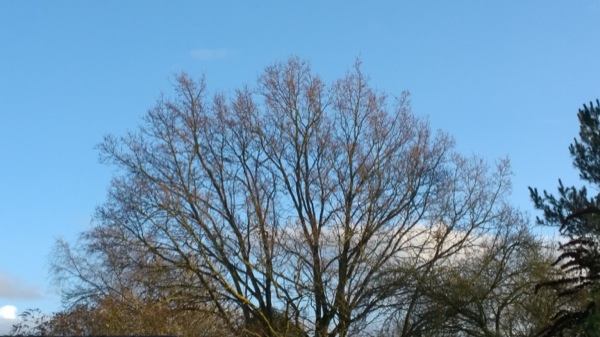
The key here is to look at maximum resolved detail on the 1520 sensor, so I used its maximum PureView zoom and then did the same with the Lumia 1020. Here are static 1:1 crops from the 1520 (top) and 1020 (bottom), note that the different zoom levels possible result in different detail framing:


Note how the extra level of PureView zoom on the 1020 (made possible by double the resolution on the sensor) results in more detail, unsurprisingly. Also notable is how the 'greenery' detail in the 1520 image comes out rather harsh and overly 'black' - something I'll come back to in the next comparison below. It should be noted, of course, that the Lumia 1520 camera algorithms will be improved in due course - we've seen how much difference the 'Black' update made to the Lumia 1020, after all.
Test 2: Sunny, dense evergreen tree at 40 metres, PureView zoom
While the light was decent, I also shot an evergreen tree in the other direction from my garden, again with PureView zoom at the 1520's maximum (so about 2x), and also with three other devices, the 1020, the 920 and the Galaxy Note II, in each case trying to match the zoom and framing so that I could put up a comparison of 1:1 crops. Yes, this meant lossy digital zoom for the last two devices, but as you can see they didn't do too badly. Here's the overall scene (after zooming):
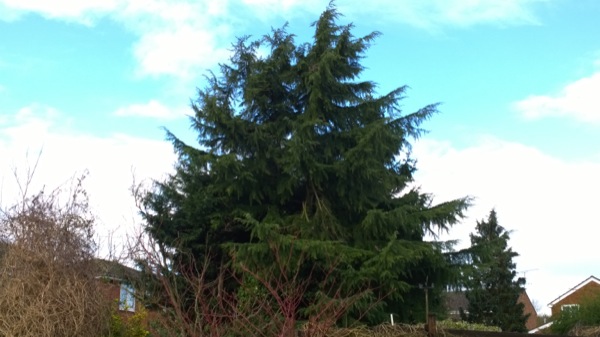
And here are some 1:1 crops from the four smartphones mentioned. From top left, clockwise: Lumia 1020, Lumia 1520, Galaxy Note II and Lumia 920:
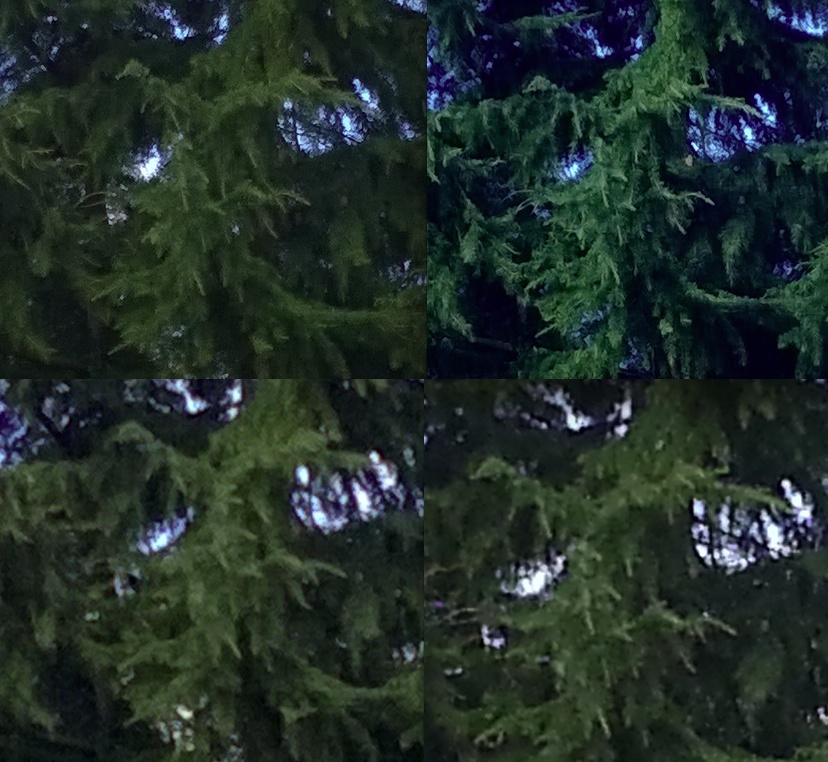
Quite an astonishing difference in processing between the Lumia 1020 and 1520, to be honest. Photographing blocks of greenery is always tricky - you've got essentially the same colour across quite a large area, yet with massive levels of intricate detail, all of which has to be represented in a compressed JPG file. The 1020 gets it about right, dialling back the sharpness with the Black update and providing tree detail that looks pleasant, even arty. The 1520, with its current algorithms (also nominally under Lumia Black, but obviously we're talking about different hardware and different chipsets), produces something that's very 'sharp' but which also looks too harsh as a result. I'd estimate that reducing the sharpening will fix this, though - and this is quite an easy fix for the Lumia 1520 product teams.
Both the digitally zoomed 8MP cameras on the 920 and Note II fare less well, as you might expect, though they at least get the colours more or less perfectly.
Test 3: Bright overcast, flood scene
With all the flooding in the UK recently, I thought I'd chip in with a scene from my locality. Here's a pub/hotel whose normally extensive grounds are now mostly under water. In this case, I didn't use any PureView zoom, in order to give you a chance to directly compare 1:1 crops from the Lumia 1520 and 1020.
Here's the overall scene, to set the context:
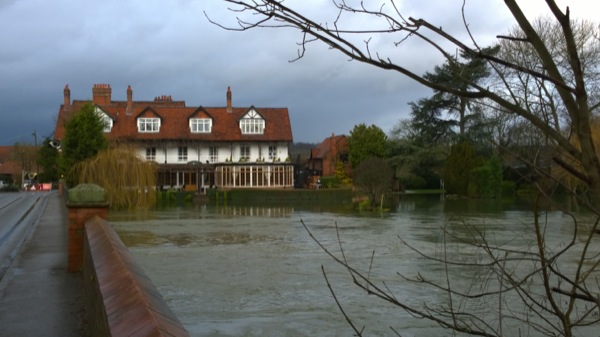
The level of detail and purity in both the Lumia 1520 and 1020 shots is impressive, but you can compare them for yourself here in our interactive comparator, looking at 1:1 crops from the centre of each. Move your mouse or pointer to switch between the two image crops:
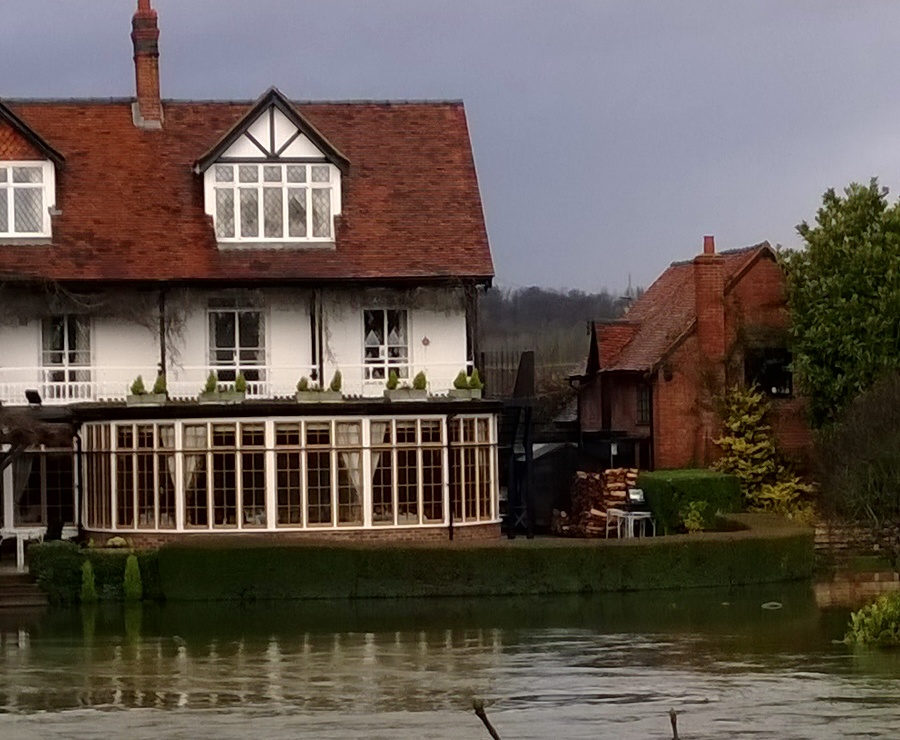
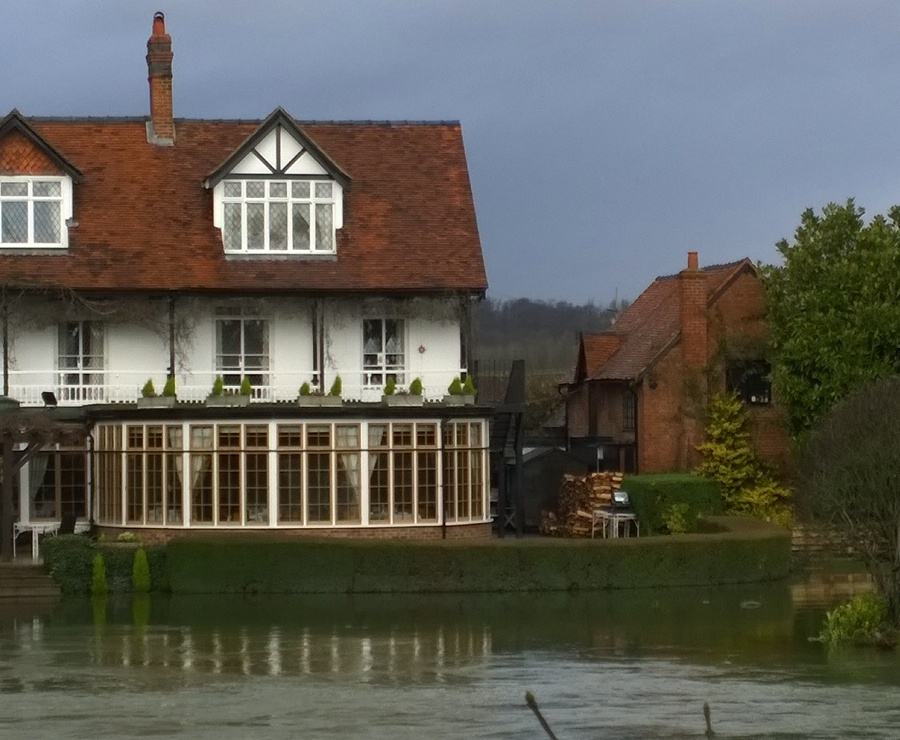
[You can download the original images from the Nokia Lumia 1520 and Lumia 1020 by using the hyperlinks, should you wish to examine the images yourself more closely]
Again, if I was being picky, I'd say that the Lumia 1520 photo looks over-processed, with contrast and sharpening set too high, and I much prefer the 1020 version. See what you think.
Test 4: Dusk, Suburban scene in low light, looking at noise and purity
Taken while it was still daylight, but only just. This is the scene, made to look a lot lighter than it actually was by the Lumias with their OIS and long shutter times(!):

A slightly boring photo, but the detail in the houses at the end of the street, around 100m away, provide a good chance to look at raw camera performance. In this case across all four of my test devices again. From top left, clockwise: Lumia 1020, Lumia 1520, Galaxy Note II and Lumia 920:
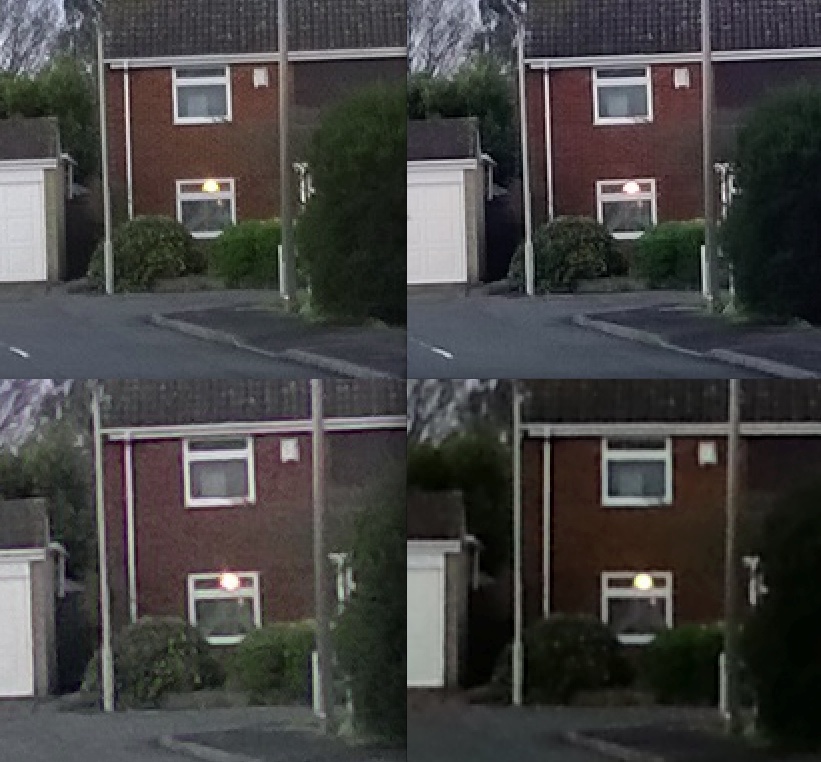
The Lumia 1020's image is quite astonishing. The combination of OIS, 7-to-one PureView oversampling and image processing algorithms tuned to perfection in Lumia Black, means that, even in this very indistinct light, there's very little noise and incredible detail, you can make out individual bricks and roof tiles. In contrast, the Lumia 1520 has 'only' about 3-to-one PureView oversampling, so there's less purity in each pixel, evidenced by some uncertainty in the brick and roof texture, though again the low light noise is kept firmly under control.
Away from the top end, the Lumia 920's non-oversampling sensor produces all the typical low light digital noise that we're used to seeing from most smartphones, while the Galaxy Note II camera manages to smooth out the noise only at the expense of smoothing out all the finer texture and detail too.
Test 5: Tricky lighting, fill-in flash needed
Persisting with the idea of challenging light, but this time introducing flash into the equation, here's a somewhat Dr Who-esque graveyard statue but with the sun very low in the sky and all the brightness up in the sky and behind. What's needed here, of course, is fill-in flash from the phones. Although the LED flash in the 1520 isn't any brighter than that in the 925 and 920, Nokia says that there are optimisations for the 1520 to tie it in with the sensor's characteristics. Let's see in this first of two flash-based tests. Here's the scene, as lit by the 1520 with LED, at least:

Without any flash, the angel's face was very dark indeed. My gut feel was that LED wouldn't be bright enough to 'fill in' effectively here, but the 1520's camera optimisations mean that it works extremely well with LED flash, making the latter seem brighter that it would on a lesser phone.
Here's our interactive comparator again, on 1:1 crops from the 1520 and 1020 photos, use your mouse or pointer:


[You can download the original images from the Nokia Lumia 1520 and Lumia 1020 by using the hyperlinks, should you wish to examine the images yourself more closely]
Full marks to the 1520 here, which gets the exposure perfectly, with everything on auto and despite only having a LED flash. In contrast, the Xenon flash on the 1020 is actually too bright for such a subject - and it's not often I say that, the 1020's photo lacks the contrast and character. Again, your thoughts welcomed.
Test 6: Party time! Freezing moving subjects
And so to a staple of camera head to heads here on All About Symbian and All About Windows Phone - the party/beer shot! Photographing human subjects - which, naturally, move - is a core scenario for many people and it's one which I make sure to always test. Here's the 'selfie' scene, snapped on the 1020:

To look for effects of blur caused by moving camera phone (unlikely, with OIS in both devices here) or moving subjects (far more likely, especially if there's music or beer involved!), let's look at 1:1 crops again, in another interactive comparator:


The Lumia 1520 camera surprised me here - the result isn't as crisp as that from the Xenon-equipped 1020, but it's still a lot better than I'd expected from a LED flash phone camera. Nokia has been experimenting a lot with pulsing its dual LED units faster and (as mentioned above) optimising the flash and sensor together, to get more from them both, and I think the shot above shows that the results are very useable.
The 1520 will still produce blur with fast moving subjects, of course (e.g. dancing), but for casual party snaps I suspect that the 1520 camera will be good enough for most people. [Of course, using the giant 1520 at a party might itself cause problems of a social kind, but that's an editorial for another day!]
Software and options
The 'Nokia Camera' software here is identical to that on the Lumia 1020 and indeed most other Lumias now that this application has rolled out across the range. Suffice it to say that there are extensive options to quickly adjust ISO, exposure, shutter speed and focus, though everything was left on automatic for all the shots here, for ease of direct comparison.
It should be noted that, as with the Lumia 1020, the 1520 offers the chance to shoot photos in joint '5MP + 16MP DNG', i.e. storing a RAW image if needed. However, as already noted, choosing this option significantly reduces your editing options on the smartphone itself, plus 1520 owners are unlikely to be Photoshop fanatics itching to play with 30MB DNG files, so I haven't considered RAW capture here. We'll put up more RAW image examples from the Lumia 1520 in due course.
______________________
The LED flash performance was really the only surprise here, since a lot of the tech here was a known quantity. The OIS has been working well in most top end Lumias for over a year now, the PureView oversampling works along the same lines as the 1020's, but not quite to the same degree (naturally), plus the overall colour accuracy and control over contrast, saturation and sharpening was slightly lacking, but understandable for a 'version 1' firmware.
Having commented several times above about processing deficiencies in the Lumia 1520's camera, it's only fair to emphasise again that it took several firmware updates for the Lumia 1020 to reach the current state of imaging nirvana. The 1520 shows promise, especially given the thinness of the design - with updates under its belt too, there's no reason why it can't improve to the same degree.
Rafe has mentioned on the podcast that he expects the 1520's camera to be re-used on several 2014 Windows Phone 8 designs. This makes a lot of sense, given the thinness of the device and of its camera - the 'hump' here is relatively small and you can imagine this hardware (shown below in context, second from the right) fitted elsewhere. Although not up to the standard of the 1020, naturally, this is a pretty good photographic baseline for multiple future devices

(From Nokia's Juha in his Engadget interview at CES 2014) From left to right, a front-facing camera, an 'entry level' camera (probably 1/4", but not a million miles from the camera size used in most other smartphones of today), the Lumia 1520's 1/2.5" camera and finally, on the right, the Lumia 1020's 1/1.5" unit, positively dwarfing the rest.
Next up, we'll have a Lumia 1520 video head to head with the 1020. I'd expect this to be closer than this stills comparison and with results from both to be uniformly excellent.
